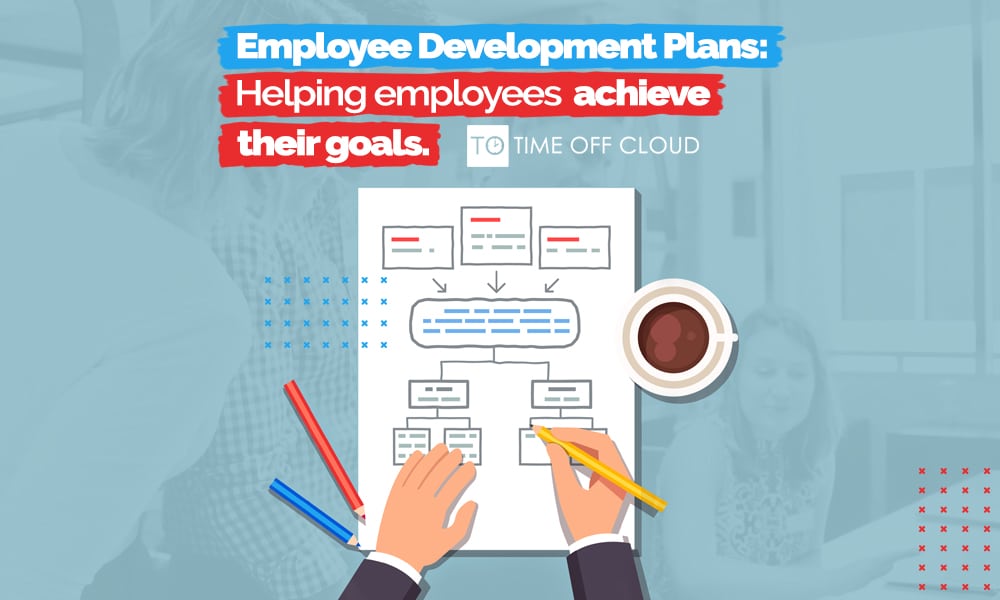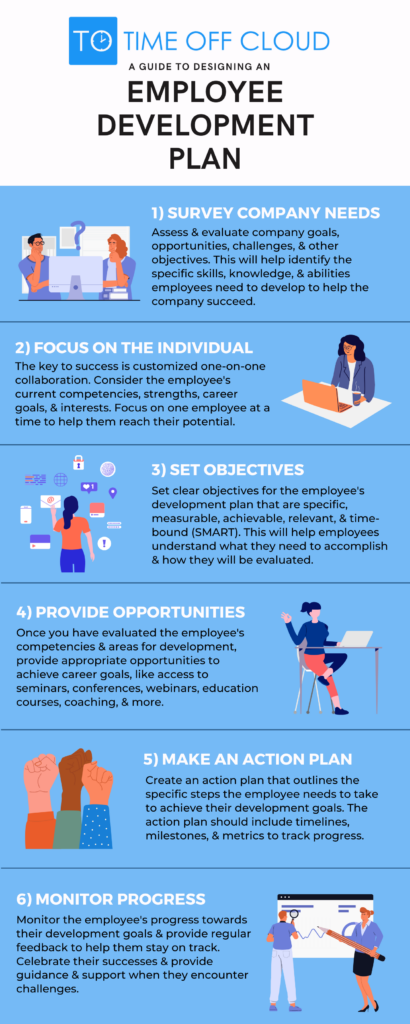Productivity is vital to a company’s success, and employees’ skills and knowledge are the building blocks of productivity. A lack of proper training and development can lead to poor performance, low-quality output, and time inefficiencies during work hours. This is where employee development plans come in.
In this article, we will discuss how employee development plans can boost productivity, key terms and elements, different types of development plans, and steps to design an employee development plan for your business.
Employee Development Plan: Key Terms & Elements
An employee development plan is a critical tool for organizations to help their employees grow and develop. It is a roadmap that outlines the specific steps employees can take to enhance their skills, knowledge, and abilities. An employee development plan typically includes goals, timelines, and metrics for tracking progress. It is designed to support employees’ growth and development, both in their current roles and in preparation for future roles.
To better understand the key terms and elements of an employee development plan, let’s explore each one in more detail:
- Organizational Needs: Organizational needs refer to the specific needs and goals of the organization. This involves assessing the organization’s goals and challenges to determine the specific skills and knowledge employees need to help the organization achieve its objectives. An employee development plan should address the specific company needs, including current and future challenges, opportunities, and initiatives.
- Employee Competence: Employee competence refers to the skills, knowledge, and abilities that an employee possesses. It involves assessing their current level of competence and identifying areas where they need to develop further. An employee development plan should outline specific training, learning, and development opportunities that will help employees improve their competence and become more effective in their roles.
- Employee Passion: Employee passion refers to the things that employees are passionate about outside of work. It involves understanding what motivates employees and what they enjoy doing. By aligning employee development plans with employees’ passions, organizations can create development opportunities that are engaging and meaningful. This can lead to greater job satisfaction, productivity, and retention rates.
- Skill gap analysis: A process that identifies the gap between an organization’s current skill set and the skills required to achieve its business objectives, skill gap analysis helps organizations identify the specific skills that need to be developed in their workforce.
- Competency model: A competency model is a framework that defines the knowledge, skills, and behaviors required for employees to perform effectively in their roles. These help organizations identify the specific competencies that employees need to develop to achieve their goals.
- Performance management: A process that includes setting goals, assessing progress, providing feedback, and making decisions about rewards and recognition. Performance management is an important part of employee development plans. It helps employees understand their strengths and weaknesses and provides guidance on areas for improvement.
- Cross-training: Cross training is the process of training employees in different roles or departments to expand their knowledge and skills. It can help employees understand how different parts of the organization work together and develop a broader perspective on the organization as a whole.
- Succession planning: Identifying and developing employees who have the potential to fill key leadership positions in the organization is succession planning. This helps organizations ensure that they have a pipeline of qualified candidates for important roles. It also provides employees with opportunities for career growth and development.
- Workforce planning: A process of forecasting future employee needs based on the organization’s strategic direction and business objectives. Workforce planning helps organizations identify the specific skills that will be required in the future. They can then develop plans to acquire or develop those skills in their workforce.
Statistics
According to a study by LinkedIn Learning, 94% of employees reported they would stay with a company longer if the company invested in learning and development. Another study by Lorman found that 74% of workers are willing to learn new skills to remain competitive, and 70% would consider leaving their current job to work for an employer that does offer development. Accordingly, more companies are adapting to modern employee expectations. In fact, 66% of managers report that learning and development is becoming a major part of their organizations. It is critical for leadership within all industries to have employee development plans in place for better workforce retention, happier employees, and improved company culture.
The Different Types of Development Plans
There are various different employee development plans you can include as part of your strategy. Some of the most common types include:
Continuing Education Courses
Continuing education courses are ideal for employees who are interested in pursuing a higher degree or certification in their field. These courses can help employees develop new skills and knowledge that are relevant to their job and industry. By providing tuition reimbursement for these courses, companies can demonstrate their commitment to employee development. They can also help employees achieve their career goals. As a result, employees are more likely to feel valued and motivated to contribute to the company’s success.
Increased Duties and Responsibilities
By assigning employees with increased duties and responsibilities, companies can help them develop new skills that are relevant to their job and industry. Employees who take on additional responsibilities can learn new ways of thinking and problem-solving. This can lead to innovation and efficiency improvements in the workplace. Additionally, employees who take on more responsibilities are more likely to feel valued and invested in the company’s success. This can lead to increased motivation and job satisfaction.
Professional Organizations and Seminar Participation
Attending seminars and conferences can help employees develop new skills and knowledge. It can also help them learn about industry trends and best practices and build valuable professional networks. This type of development plan can benefit employees by providing them with opportunities to learn from industry experts and build relationships with colleagues in their field. Additionally, companies can benefit from employees who attend these events by gaining access to new ideas and best practices.
Coaching and Mentoring Programs
Coaching and mentoring programs can help employees develop new skills, knowledge, and competencies. These programs provide them with guidance and support from experienced colleagues. They can help employees improve their performance and achieve their career goals, as well as develop a deeper understanding of the company’s culture and values. This will build a stronger and more engaged workforce and by develop a pipeline of future leaders.
Job Shadowing and Cross-Training
Job shadowing and cross-training programs can help employees develop new skills and knowledge. It provides them with opportunities to observe and learn from colleagues in different roles or departments. These programs can help employees gain a better understanding of the company’s operations and processes. It wll also help to develop new competencies and perspectives. Additionally, companies can benefit from job shadowing and cross-training programs by building a more versatile and adaptable workforce and by improving communication and collaboration between different parts of the organization.
By offering a variety of development plans, companies can help their employees achieve their career goals, improve their performance, and contribute to the company’s success. Companies that invest in employee development are more likely to retain their top talent and build a strong, engaged workforce.
Designing an Employee Development Plan for Your Organization
Check out the following infographic for tips on creating an effective employee development plan for your company.
In Conclusion
Employee development plans help employees achieve their goals, produce more quality output, and become more time-efficient and productive at work. It is an excellent investment of time, energy, and resources that will eventually reflect on the company’s overall productivity in the long run.
Consider using time off tracking software like Time Off Cloud to ensure that employees’ development plans align with their time off requests, increasing their satisfaction and motivation. Schedule a demo today.



